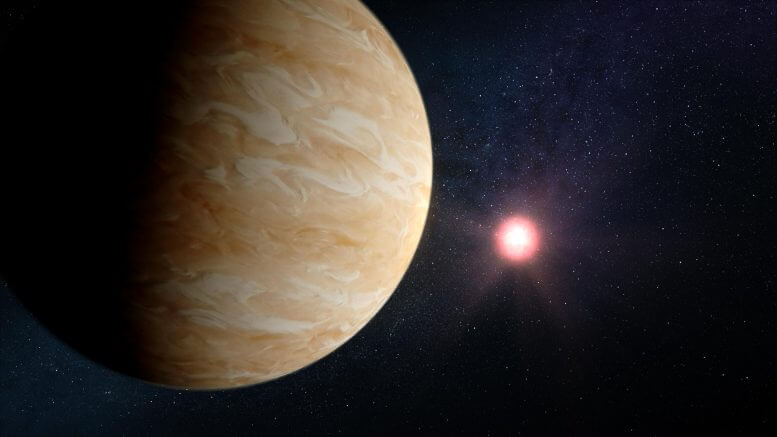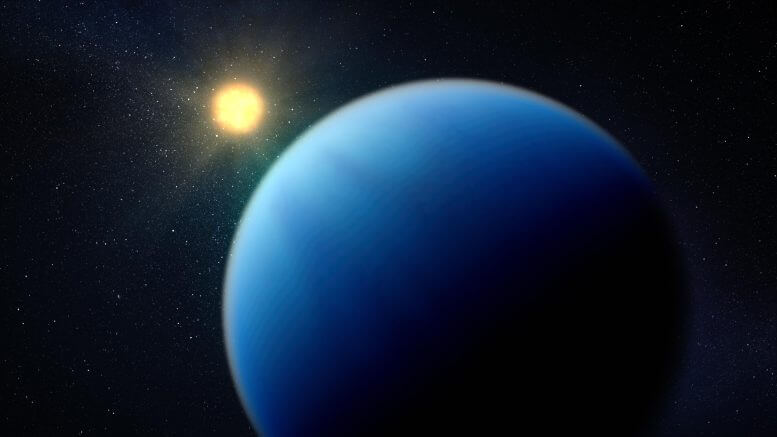NASA's James Webb Space Telescope is designed to pick up the haze surrounding warm sub-Neptune planets - planets that range in size from Earth to Neptune, but orbit their suns at a closer distance than the orbits of Mercury.

Detailed atmospheric studies will provide important insights into some of the most common – and mysterious – planets known in the galaxy.
The Milky Way is full of enigmatic planets larger than Earth but smaller than Neptune, which move around their star faster and closer than a hot planet orbits the sun, or in short hot sub-Neptune planets. Such planets lie light-years away, obscured by fog or clouds and with nothing comparable in our solar system, the exact nature of these near-ubiquitous sub-Neptunian-sized planets is still a mystery. What are they made of? How were they created? And what can be learned from them about planets and planetary development in general?
With its unprecedented ability to measure very subtle differences in the brightness and color of dim infrared light, NASA's James Webb Space Telescope is poised to dispel the fog surrounding the nature and origin of the most common type of planet in the Milky Way.
More than half of the solar-like star systems surveyed in the Milky Way contain a mysterious type of planet unlike any other planet in the Solar System. in our solar system.
Examples of this are sub-Neptune planets. Larger than Earth, smaller than Neptune, and orbiting closer to their stars than Mercury orbits the Sun, these warm to hot sub-Neptune planets are the most common type of planet observed in the galaxy. But although researchers have been able to measure basic properties – including size, mass and orbit – of hundreds of these planets, their fundamental nature remains unclear.
Are they dense balls of rock and iron like on Earth, which are covered in thick layers of hydrogen and helium gas? Or are they composed of less dense mixtures of rock and ice, surrounded by vaporous, water-rich atmospheres? With limited data and no planets of similar size and orbit in our solar system for comparison, these questions have been difficult to answer.
"What are these planets? How are they created? Why don't we have them in our solar system? These are fundamental questions," explains Jacob Bean, an astronomer from the University of Chicago who has led many observations of planets outside the solar system.
It seems that what prevents us from understanding the nature of these planets are the aerosols, tiny particles and droplets that make up clouds or haze. These particles scatter the starlight, eroding the prominent spectral peaks into subtle ripples and rendering the spectrum virtually useless for determining the composition of the gas.
But with Web, the researchers are confident that our view of these sub-Neptunian planets will be improved. Two observation programs are planned to take place in the first year of Web activity. In one, researchers will use Webb's unique powerful capabilities to study two sub-Neptune-sized planets: GJ 1214 b, the sub-Neptune archetype; and TOI-421 b, another recently discovered planet.
Sub-Neptune Archetype: GJ 1214b
GJ 1214 b is a hot sub-Neptune orbiting a red dwarf star near the Solar System and has been the subject of dozens of studies. Its short orbital period, its large size in relation to its star, and its relative proximity to Earth facilitate (as far as stars that travel outside the solar system are concerned) the observation. While its status as a sub-Neptune - and according to the lead researcher, "the most mysterious outer planet we know" - make it a worthy target for investigation.

TOI-421b
It is not clear what the aerosols around a hot Neptunian star like GJ 1214 b are composed of, but they could be similar to those that make up the haze-like smog found on the Saturnian moon Titan. To test this hypothesis, the researchers decided to focus on TOI-421 b, a planet similar in size and density to GJ 1214 b, but thought to be too hot to sustain a sooty haze.
The James Webb Space Telescope will be the world's leading space science observatory when it launches in December 2021. Webb will solve mysteries in our solar system, look beyond to distant worlds around other stars, and explore the mysterious structures and origins of our universe and our place. at him. Webb is an international program led by NASA with its partners, ESA (European Space Agency), and the Canadian Space Agency.

Figure comparing the size of the sub-Neptunian exoplanets TOI-421 b and GJ 1214 b to Earth and Neptune-Rahab. TOI-421 b and GJ 1214 b are both between Earth and Neptune in terms of radius, mass and density. The low densities of both exoplanets indicate that they must have thick atmospheres. The exoplanets are arranged from left to right in ascending order of radius and mass: A picture of the country from the climate observatory in deep space: The Earth is a rocky planet with an average radius of 6,370 km, a mass of approximately 6 billion trillion tons and a density 5.5 times that of water.
אFigure of TOI-421 b: TOI-421 is a hot sub-Neptunian exoplanet with a radius of 2.68 times that of Earth, a mass of 7.2 times that of Earth, and a density of 2.05 times that of water. Illustration of GJ 1214 b: GJ 1214 b is a warm sub-Neptunian exoplanet with a radius of 2.74 times that of Earth, a mass of 8.2 times that of Earth, and a density of 2.2 times that of water.Image of Neptune-Rahab from Voyager 2: Neptune is an ice giant with a radius 3.88 times that of Earth (which gives it a volume of nearly 58 times that of Earth), a mass 17 times that of Earth and a density of only 1.6 times that of water. The figure shows the planets to scale in terms of radius, but not position in space or distance from the stars theirs. Earth and Neptune orbit the Sun, while TOI-421 b orbits a Sun-like star about 244 light-years away, and GJ 1214 b orbits a small red dwarf star about 48 light-years away.
Credit: NASA, ESA, CSA, and D. Player (STScI)
More of the topic in Hayadan:
